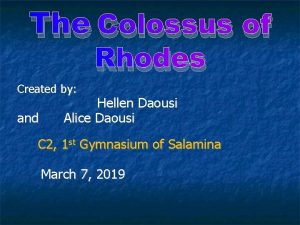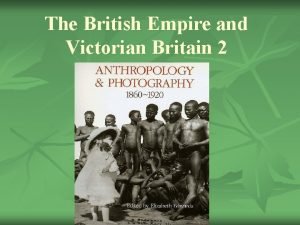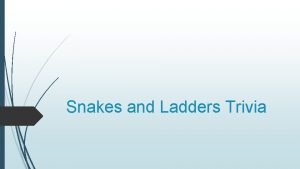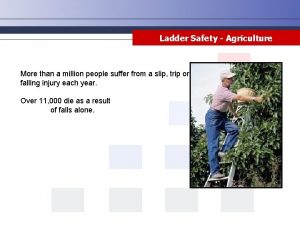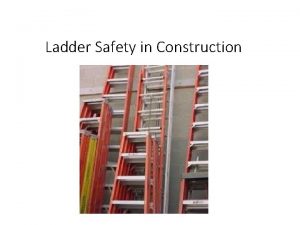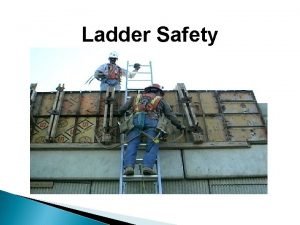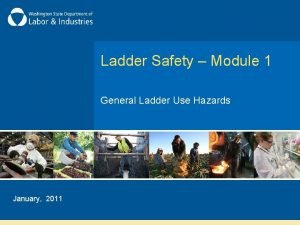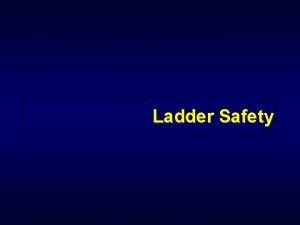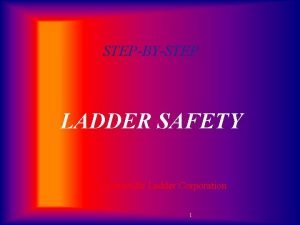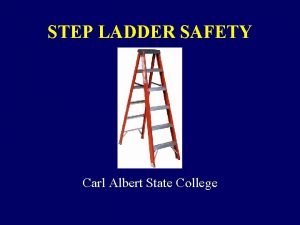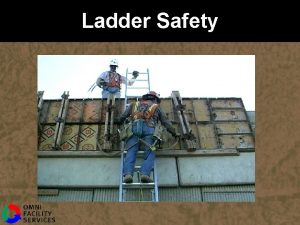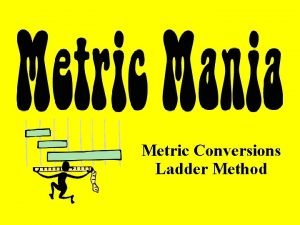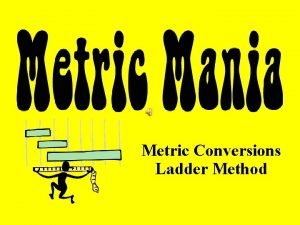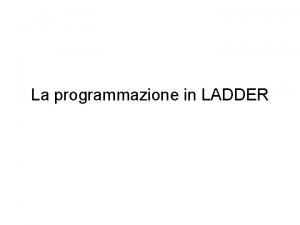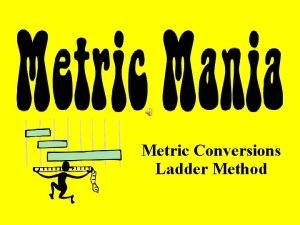Ladder Safety COURSE Rhodes University Introduction to Ladder






























- Slides: 30

Ladder Safety COURSE Rhodes University Introduction to Ladder Safety 1

WHY? 2

Falls in the Workplace l 1 in 6 of lost-time work injuries are a result of slips, trips and falls l 25% of all accidents are falls from elevated positions l 60% of these are from less than 3 metres l 16% of fatal falls are from LADDERS 3

Falls in the Workplace Common causes of ladder accidents: 1. Overreaching 2. Unsecured ladder 3. Climbing one-handed 4. Losing balance on top rung 5. Using a worn/damaged ladder that breaks 4

Law: Working at Heights • OHS Act General Safety Regulations 6: “No employer shall require or permit any person to work in an elevated position, and no person shall work in an elevated position, unless such work is performed safely from a ladder or scaffolding, or from a position where such person has been made as safe as if he were working from scaffolding. ” • OHS Act General Safety Regulations 13 A: Ladders “…ensure that every ladder is constructed of sound material and is suitable for the purpose for which it is used. . . ” and secure, rungs not loose/damaged, < 9 m long, wood not cracked/damaged, no falling items, fixed ladder has cage. • Construction Regulations 2014 : “fall risk” …any potential exposure to falling from/off/into… • Full risk assessment must be done • Fall protection plan must be updated – annually, or if any changes in scope of work, personnel, venue, etc. Copyright ã 2014 Progressive Business Publications 5

WHAT? 6

Types of Ladders • Stepladders (A-frame) • Single (portable) ladders • Fixed ladders • ALL ladders must be on a ladder register Important to keep records! Copyright ã 2014 Progressive Business Publications 7

Stepladders (A-frame) • Self-supporting, fold-out, non-adjustable • Good for low heights • Use only when all 4 legs are on a solid, level surface • Never use top two levels for steps • If locking device is damaged or missing, DO NOT USE Copyright ã 2014 Progressive Business Publications Wooden ladder

Metal ladder

Single (Portable) Ladders • Non-self-supporting – lean against wall or other support • Use leg extensions or non-slip feet to ensure stability • Use ladder with correct duty rating • Designed to support at least 4 x maximum intended load • Must extend above roof at least 90 cm Copyright ã 2014 Progressive Business Publications 10

11

Fixed Ladders • Built into building – can’t be moved • Often encased in cages or wells – for fall arrest • Supports at least two loads of 115 kg. 12

Aluminium, steel or fiberglass? • Aluminium: strong, lightweight, corrosion resistant • Steel: strong, economical, corrosion resistant • Fibreglass: electrically non-conductive, strong, leading choice of professionals 13

HOW? 14

Inspecting Ladders Before Each Use • Missing or damaged components: Do NOT use or make temporary repairs! • Loose fasteners: Do NOT use or make temporary repairs! • Oil, wet paint, mud, grease, etc: CLEAN off all slip hazards! • Damaged, worn or exposed to fire or chemicals: MARK with ‘Do Not Use’ tag, DESTROY asap! • Use correct ladder for safe working height Copyright ã 2014 Progressive Business Publications 15

16

Inspecting Ladders Before Each Use • Inspect area around ladder for slip hazards • Rating label must be intact – to indicate duty rating: § Light duty (90 kg): “domestic” painting, yard work § Medium duty (100 kg): “light commercial” painting, cleaning, light repair § Heavy duty (115 kg): “industrial” general contracting, building, maintenance, dry walling § Extra heavy duty (135 kg): “professional” industrial construction, building, roofing Copyright ã 2014 Progressive Business Publications 17

18

Placement • If surface isn’t level, adjust legs • If needed, use a board or platform for a base • NEVER use an unstable base (e. g. boxes, bricks) • NEVER use a ladder as a horizontal platform, or on a scaffold platform, or lean a stepladder against a wall. Copyright ã 2014 Progressive Business Publications 19

20

Setting Up • Step 1: Lay ladder on ground with base resting against bottom of the wall • Step 2: Lift top of the ladder; walk under toward the wall, moving hands from rung to rung • Step 3: Pull out base when ladder top touches the wall • 4 to 1 rule: for every 1 m high, move ladder base out ¼m (if 4 m high, base out 1 m) Copyright ã 2014 Progressive Business Publications 21

Securing the Ladder • Tie the rope to both side rails of the base – to stakes/blocks/sandbags on ground • Use ladder stays when leaning against window • Station a co-worker at the foot of the ladder (facing ladder with a hand on each side rail, & a foot on bottom rung) Be careful, s/he is at risk of being hit if you/items fall! • Use a pole chain when leaning against a pole Copyright ã 2014 Progressive Business Publications 22

Safe Climbing • Face the ladder • One step at a time • Grab rungs, not side rails … both hands! use • 3 -point contact rule (hands, feet) • Harness must be used if you need to work with both hands Copyright ã 2014 Progressive Business Publications 23

Safe Climbing • Do not move the ladder while you are on it • Follow ‘belt buckle rule’ to avoid overreaching • Never go higher than red step (SA metal ladders) • Avoid carrying bulky loads (rather use tool belt / backpack / pulley rope) • If dizzy: drape arms around rungs, rest head • NEVER climb a ladder under influence of alcohol or flu! Copyright ã 2014 Progressive Business Publications 24

High Traffic Areas • Hallways, doorways, driveways • Redirect traffic • Lock and block doors • Station a co-worker on other side of the door • Remember: objects falling off a ladder can cause injury to by passers Copyright ã 2014 Progressive Business Publications 25

Working Around Electricity • Never lean a ladder against electrical lines • Place the ladder so that if it falls, it will not touch the power lines • Check for overhead clearance and keep a safe distance from overhead/electric wires (at least 3 metres) • Use non-conductive (fiberglass/wooden) ladder • Avoid using a metal or wet wooden ladder Copyright ã 2014 Progressive Business Publications 26

Inspecting Ladders - Quarterly 1. 2. 3. 4. 5. 6. 7. 8. 9. 10. 11. 12. 13. 14. 15. RU ladder inspection checklistwww. ru. ac. za/safety/resources/ladders Ladder has easily readable asset tag or unique identity number Ladder rating label is intact and easy to read Ladder is stable, not wobbly (from side strain etc) Rungs all present, evenly spaced, not worn, smooth or loose Side rails, rungs, spreaders and braces not broken/cracked/split Spreaders and hinges not bent, loose, or with broken stops Ladder has no sharp edges, loose screws, bolts or nails Ladder is clean, not greasy (slippery) or painted (hiding defects) Non-slip base/safety feet intact, not damaged or worn smooth Ladder is stored safely and correctly All staff who routinely make use of this ladder have been instructed on ladder safety/attended a ladder safety course Extension ladder: rope is strong, not frayed/deteriorated Extension ladder: extension locks not loose/broken/missing Wooden ladder: free of splinters, cracks or decay Ladder is fit for use Copyright OR Comments on actions taken ã 2014 Progressive Business Publications 27

WELL? 28

Remember • 25% of all accidents are falls from elevated positions • Inspect equipment regularly & keep records! • Follow proper placement, setup and climbing procedures • Redirect pedestrians in high-traffic areas • Keep a safe distance from overhead/electric wires Copyright ã 2014 Progressive Business Publications 29

More Info Rhodes University: Safety, Health & Environment SHE Officer - RU ext 7205 safety@ru. ac. za Ladder Safety: www. saladder. co. za www. heightsafety. co. za www. ru. ac. za/safety/resources/ladders
 Rebuild colossus of rhodes
Rebuild colossus of rhodes Colossus of rhodes facts
Colossus of rhodes facts Cecil rhodes
Cecil rhodes Tincion
Tincion Olly rhodes
Olly rhodes Rhodes writing center
Rhodes writing center Edwin rhodes elementary school lunch menu
Edwin rhodes elementary school lunch menu Cartoon interpretation
Cartoon interpretation Cecil rhodes political cartoon
Cecil rhodes political cartoon Jenny rhodes agent
Jenny rhodes agent Polydoros of rhodes
Polydoros of rhodes Berlin conference cecil rhodes quote
Berlin conference cecil rhodes quote Dinocrates of rhodes
Dinocrates of rhodes Collussus of rhodes
Collussus of rhodes Jason rhodes jpl
Jason rhodes jpl Mel rhodes
Mel rhodes Lighthouse seven wonders of the ancient world
Lighthouse seven wonders of the ancient world Snakes in rhodes
Snakes in rhodes Woolworths rhodes
Woolworths rhodes Rhodes 24
Rhodes 24 Hayford and rhodes
Hayford and rhodes Ali rhodes
Ali rhodes Cecil rhodes definition world history
Cecil rhodes definition world history Doppler effect youtube
Doppler effect youtube Toni rhodes
Toni rhodes Cecil rhodes karikatur
Cecil rhodes karikatur T junction of stretcher bond
T junction of stretcher bond Course number and title
Course number and title Course interne moyenne externe
Course interne moyenne externe Tripod inspection checklist
Tripod inspection checklist Tractor safety course oregon
Tractor safety course oregon
